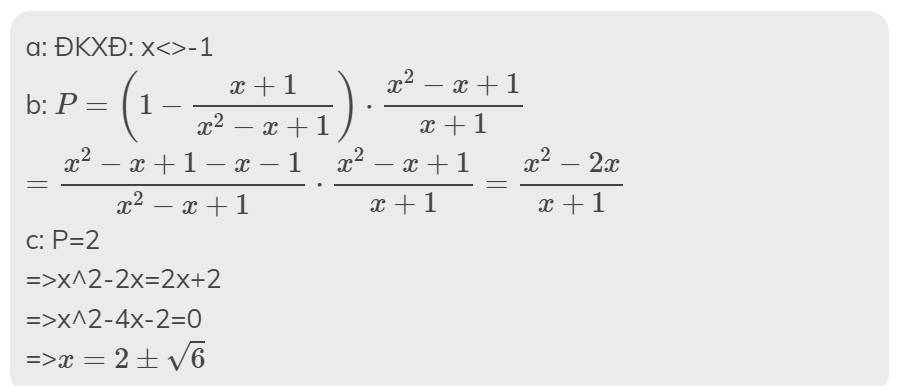Hãy nhập câu hỏi của bạn vào đây, nếu là tài khoản VIP, bạn sẽ được ưu tiên trả lời.

a,ĐK: \(\hept{\begin{cases}x\ne0\\x\ne\pm3\end{cases}}\)
b, \(A=\left(\frac{9}{x\left(x-3\right)\left(x+3\right)}+\frac{1}{x+3}\right):\left(\frac{x-3}{x\left(x+3\right)}-\frac{x}{3\left(x+3\right)}\right)\)
\(=\frac{9+x\left(x-3\right)}{x\left(x-3\right)\left(x+3\right)}:\frac{3\left(x-3\right)-x^2}{3x\left(x+3\right)}\)
\(=\frac{x^2-3x+9}{x\left(x-3\right)\left(x+3\right)}.\frac{3x\left(x+3\right)}{-x^2+3x-9}=\frac{-3}{x-3}\)
c, Với x = 4 thỏa mãn ĐKXĐ thì
\(A=\frac{-3}{4-3}=-3\)
d, \(A\in Z\Rightarrow-3⋮\left(x-3\right)\)
\(\Rightarrow x-3\inƯ\left(-3\right)=\left\{-3;-1;1;3\right\}\Rightarrow x\in\left\{0;2;4;6\right\}\)
Mà \(x\ne0\Rightarrow x\in\left\{2;4;6\right\}\)

để A xác định
\(\Rightarrow\hept{\begin{cases}x+2\ne0\\x-2\ne0\\x^2\ne4\end{cases}}\Rightarrow x\ne\pm2\)
\(A=\frac{4}{x+2}+\frac{3}{x-2}-\frac{5x-6}{x^2-4}\)
\(A=\frac{4.x-8}{\left(x+2\right).\left(x-2\right)}+\frac{3.x+6}{\left(x-2\right).\left(x+2\right)}-\frac{5x-6}{\left(x-2\right).\left(x+2\right)}\)
\(A=\frac{4x-8+3x+6-5x+6}{\left(x+2\right).\left(x-2\right)}=\frac{2.\left(x+2\right)}{\left(x+2\right).\left(x-2\right)}=\frac{2}{x-2}\)
\(\frac{4}{x+2}+\frac{3}{x-2}-\frac{5x-6}{x^2-4}=\frac{4}{x+2}+\frac{3}{x-2}-\frac{5x-6}{\left(x+2\right)\left(x-2\right)}\)
\(=\frac{4x-8}{\left(x+2\right)\left(x-2\right)}+\frac{3x+4}{\left(x-2\right)\left(x+2\right)}-\frac{5x-6}{\left(x-2\right)\left(x+2\right)}=\frac{4x-8+3x+4-5x+6}{\left(x+2\right)\left(x-2\right)}\)
\(=\frac{2x+2}{\left(x+2\right)\left(x-2\right)}=\frac{2x+2}{x^2-4}\)
C, \(x=4\Rightarrow A=\frac{2x+2}{x^2-4}=\frac{-6}{12}=\frac{-1}{2}\)
d, \(A\inℤ\Leftrightarrow2x+2⋮x^2-4\Leftrightarrow2x^2+2x-2x^2+8⋮x^2-4\Leftrightarrow2x+8⋮x^2-4\)
\(\Leftrightarrow2x^2+8x⋮x^2-4\Leftrightarrow16⋮x^2-4\)
\(x^2-4\inℕ\)
\(\Rightarrow x^2\in\left\{0;4;12\right\}\)
Thử lại thì 12 ko là số chính phương vậy x=0 hoặc x=2 thỏa mãn
mk học lớp 6 mong mn thông cảm nếu có sai sót

Bài 1: ĐKXĐ:`x + 3 ne 0` và `x^2+ x-6 ne 0 ; 2-x ne 0`
`<=> x ne -3 ; (x-2)(x+3) ne 0 ; x ne2`
`<=>x ne -3 ; x ne 2`
b) Với `x ne - 3 ; x ne 2` ta có:
`P= (x+2)/(x+3) - 5/(x^2 +x -6) + 1/(2-x)`
`P = (x+2)/(x+3) - 5/[(x-2)(x+3)] + 1/(2-x)`
`= [(x+2)(x-2)]/[(x-2)(x+3)] - 5/[(x-2)(x+3)] - (x+3)/[(x-2)(x+3)]`
`= (x^2 -4)/[(x-2)(x+3)] - 5/[(x-2)(x+3)] - (x+3)/[(x-2)(x+3)]`
`=(x^2 - 4 - 5 - x-3)/[(x-2)(x+3)]`
`= (x^2 - x-12)/[(x-2)(x+3)]`
`= [(x-4)(x+3)]/[(x-2)(x+3)]`
`= (x-4)/(x-2)`
Vậy `P= (x-4)/(x-2)` với `x ne -3 ; x ne 2`
c) Để `P = -3/4`
`=> (x-4)/(x-2) = -3/4`
`=> 4(x-4) = -3(x-2)`
`<=>4x -16 = -3x + 6`
`<=> 4x + 3x = 6 + 16`
`<=> 7x = 22`
`<=> x= 22/7` (thỏa mãn ĐKXĐ)
Vậy `x = 22/7` thì `P = -3/4`
d) Ta có: `P= (x-4)/(x-2)`
`P= (x-2-2)/(x-2)`
`P= 1 - 2/(x-2)`
Để P nguyên thì `2/(x-2)` nguyên
`=> 2 vdots x-2`
`=> x -2 in Ư(2) ={ 1 ;2 ;-1;-2}`
+) Với `x -2 =1 => x= 3` (thỏa mãn ĐKXĐ)
+) Với `x -2 =2 => x= 4` (thỏa mãn ĐKXĐ)
+) Với `x -2 = -1=> x= 1` (thỏa mãn ĐKXĐ)
+) Với `x -2 = -2 => x= 0`(thỏa mãn ĐKXĐ)
Vậy `x in{ 3 ;4; 1; 0}` thì `P` nguyên
e) Từ `x^2 -9 =0`
`<=> (x-3)(x+3)=0`
`<=> x= 3` hoặc `x= -3`
+) Với `x=3` (thỏa mãn ĐKXĐ) thì:
`P = (3-4)/(3-2)`
`P= -1/1`
`P=-1`
+) Với `x= -3` thì không thỏa mãn ĐKXĐ
Vậy với x= 3 thì `P= -1`

a: ĐKXĐ: x<>-1
b: \(P=\left(1-\dfrac{x+1}{x^2-x+1}\right)\cdot\dfrac{x^2-x+1}{x+1}\)
\(=\dfrac{x^2-x+1-x-1}{x^2-x+1}\cdot\dfrac{x^2-x+1}{x+1}=\dfrac{x^2-2x}{x+1}\)
c: P=2
=>x^2-2x=2x+2
=>x^2-4x-2=0
=>\(x=2\pm\sqrt{6}\)

a) ĐKXĐ: a2-1 ≠0 ⇔ (a-1)(a+1)≠0 ⇔\(\left[{}\begin{matrix}a-1\ne0\\a+1\ne0\end{matrix}\right.\Leftrightarrow\left[{}\begin{matrix}a\ne1\\a\ne-1\end{matrix}\right.\)
b) A=\(\dfrac{2a^2}{a^2-1}-\dfrac{a}{a+1}+\dfrac{a}{a-1}\) , a≠1, -1
=\(\dfrac{2a^2}{\left(a-1\right)\left(a+1\right)}-\dfrac{a\left(a-1\right)}{\left(a-1\right)\left(a+1\right)}+\dfrac{a\left(a+1\right)}{\left(a-1\right)\left(a+1\right)}\)
=\(\dfrac{2a^2-a\left(a-1\right)+a\left(a+1\right)}{\left(a-1\right)\left(a+1\right)}\)
=\(\dfrac{2a^2-a^2+a+a^2+a}{\left(a-1\right)\left(a+1\right)}\)
=\(\dfrac{2a^2+2a}{\left(a-1\right)\left(a+1\right)}\) =\(\dfrac{2a\left(a+1\right)}{\left(a-1\right)\left(a+1\right)}\) =\(\dfrac{2a}{a-1}\)
vậy A =\(\dfrac{2a}{a-1}\) với a≠1,-1.
c) Có:A= \(\dfrac{2a}{a-1}\) = \(\dfrac{2a-2+2}{a-1}=\dfrac{2\left(a-1\right)+2}{a-1}=2+\dfrac{2}{a-1}\)
Để a∈Z thì a-1 ∈ Z ⇒ (a-1) ∈ Ư(2) =\(\left\{1;-1;2;-2\right\}\)
Ta có bảng sau:
Vậy để biểu thức A có giá trị nguyên thì a∈\(\left\{2;0;3\right\}\)
a) ĐKXĐ: \(a\notin\left\{1;-1\right\}\)
b) Ta có: \(A=\dfrac{2a^2}{a^2-1}-\dfrac{a}{a+1}+\dfrac{a}{a-1}\)
\(=\dfrac{2a^2}{\left(a+1\right)\left(a-1\right)}-\dfrac{a\left(a-1\right)}{\left(a+1\right)\left(a-1\right)}+\dfrac{a\left(a+1\right)}{\left(a+1\right)\left(a-1\right)}\)
\(=\dfrac{2a^2-a^2+a+a^2+a}{\left(a+1\right)\left(a-1\right)}\)
\(=\dfrac{2a^2+2a}{\left(a+1\right)\left(a-1\right)}\)
\(=\dfrac{2a\left(a+1\right)}{\left(a+1\right)\left(a-1\right)}\)
\(=\dfrac{2a}{a-1}\)
c) Để A nguyên thì \(2a⋮a-1\)
\(\Leftrightarrow2a-2+2⋮a-1\)
mà \(2a-2⋮a-1\)
nên \(2⋮a-1\)
\(\Leftrightarrow a-1\inƯ\left(2\right)\)
\(\Leftrightarrow a-1\in\left\{1;-1;2;-2\right\}\)
\(\Leftrightarrow a\in\left\{2;0;3;-1\right\}\)
Kết hợp ĐKXĐ, ta được: \(a\in\left\{0;2;3\right\}\)
Vậy: Để A nguyên thì \(a\in\left\{0;2;3\right\}\)